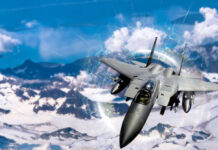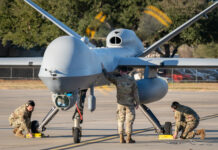If you declare war on something, industry will make goods to sell to the warriors. This has been the case since antiquity. The so-called ‘War on Drugs’ is no exception.
A variety of techniques and technologies have come into use in the worldwide struggle against smuggling, manufacturing, and sale of dangerous drugs. The substances of immediate concern shift with the times. At various points, heroin, cannabis, cocaine, methamphetamine have been and continue to be of concern. Fentanyl is a more recent threat. Regardless of substance, the need to detect traces of drugs to guide investigations and searches, as well as the need to characterise suspicious substances, are valid operational requirements. It should be noted that an area of active law enforcement and border protection concern is the detection and identification of various precursor substances used to make illegal drugs. Furthermore, there is a serious overlap with explosive detection and identification, both in end-user and in hardware.
Non-electronic methods
Snoop dogs
Drug detection started with non-electronic methods. Old techniques are still valid. Euphemistically referred to as ‘manual search techniques’, border guards, custom inspectors, and police can and do tear things apart searching for drugs. This is crude, but effective. A thorough physical search is very good at finding drugs. However, it is time-consuming, alienates the public that the authorities are trying to protect, and is prone to abuse. Tearing apart every car and searching every box in every cargo container is not only unwise, it is logistically impossible, and mankind has long ago enlisted dogs to help. In the time it would take to disassemble a car thoroughly enough to find a small parcel of hidden drugs, a trained dog and handler could screen hundreds of cars.

Credit: USMC/Carlos Guerra
Dogs are a time-honoured approach to detecting hidden drugs. Well-trained drug detection dogs are in use around the world. When well-trained and used by a skilled handler, they are highly sensitive at detecting drugs. They also work much faster than many electronic techniques. Trained dogs paired with trained handlers can screen at speed and often can lead the search team to the exact location of a drug stash. A good dog can lead the handler to a drug stash, a task which automated devices can rarely perform.
Detection dogs are not without their issues. They are expensive and need a well-trained handler. The dogs need to be looked after and a skilled handler knows how to maintain the correct work-rest cycle. Overworked dogs do not perform well, and they are, like their handlers, prone to distraction in adverse environments. Dogs have been known to get sick or injured. Various experts point out the hazards of injury to dogs from inhalation of drugs or precursors. Likewise, inadvertent exposure to caustic chemicals, some of which are used in clandestine drug production or even found normally as household substances, can temporarily or even permanently damage a dog’s nose. Furthermore, a dog will not be able to tell you what drug it has detected.
Wet chemistry
The other major category of non-electronic drug detection is wet chemistry. All of the major categories of illegal drugs are easily detectable by a range of traditional chemistry techniques. Although chemical processes in actual laboratories have been around for well over a century, and field techniques are often back-stopped by forensic analysis in laboratories, rather a lot of chemical reactions are easily achieved with simple hardware in field environments with far less training needed. Many chemical reactions that show a visible colour change can identify, at least by broad class, all of the major drugs of concern. Because of this, industry has ensured that a bewildering array of kits, swabs, vials, detector papers, ampoules, and related paraphernalia are available at reasonable prices. This market is highly fractionated and well served by a global web of specialist small and medium enterprises (SMEs). In some countries, kits are even available for household use, with packaging aimed at concerned parents.

Credit: G. Climer
Wet chemistry techniques and products have drawbacks. They are primarily designed for users with a sporadic requirement. You would burn through a lot of consumables doing lots of tests every day. They will not help you find hidden drugs and are generally meant for identifying a sample of visible product. In other words, they are there to answer the ‘is this substance a narcotic?’ question, not the ‘which car contains the drugs?’ and the ‘where are the narcotics hidden in this car?’ questions.
Electronic techniques
IMS
The most commonplace electronic means for detecting illegal drugs is ion mobility spectrometry, often known by its acronym IMS. Readers of this magazine will have seen this technology mentioned in articles about chemical weapons detection, where IMS is one of the leading technologies for rapid electronic detection. The same technical approach, which uses some sort of ionisation source to ionise a vapour sample, can detect molecules of various drugs. By ionising a sample of vapour and measuring the behaviour of this sample, the molecular weight of the compound can be deduced, and the substance identified. This same approach works for many types of explosives as well, and the products in this area are often configured for both explosive and drug detection.
Unlike many toxic industrial chemicals and most chemical warfare agents, illegal drugs tend to have extremely low volatility. This means that merely sniffing the air is not likely to be the most useful way to identify traces of drugs. A typical operating principle for an IMS drug detector is to use a swatch or swab of a special cloth or paper, which has been rubbed on an area of interest, such as a door handle, the outside of a suitcase, or something similar. The sample swab is inserted into the IMS detector, which heats up the sample to make the drug traces (or explosive traces) more likely to evaporate into a gaseous form that can be ionised and analysed.
A number of firms are active in this market-space, often marketing the same or nearly identical product configurations for both explosive and drug trace detection. Smiths Detection (UK) has long held a large share in this market, with its Ionscan series of desktop-sized systems and Sabre series of portable systems. Their long-term rivals Bruker (DE) and Rapiscan (USA) field IMS trace detection production of comparable scope and specifications. Several other manufacturers are also active in this space such as Autoclear (Canada), Nuctech (China), and Securscan (Italy).
IMS technology does have some aspects that can be seen as operational drawbacks. Many of them have some sort of radioactive isotope as their ionisation source, which means that they come under radiation safety and licensing regimes, thus increasing training, maintenance, and paperwork burden. While the sensitivity of an instrument – its ability to detect a small number of molecules– is an advantage in many ways, the high sensitivity of IMS devices can also pose issues.
For starters, they are trace detectors, not bulk-sample identifiers. Many devices are calibrated to be very sensitive to detect small traces and can be overloaded by a strong sample. A system swamped with a strong sample of opiates or cocaine might take many hours to clear down, being out of service until it can cleanse itself. In practice, some detectors could be so overwhelmed that they would need factory servicing. Cross-contamination can also be a problem, and operators who do not follow correct procedures may cause numerous false positives. For example, the floor of a rental van that had held some drugs might give a positive reading days or weeks after it has been hired out to someone else. For these reasons, training is very important with IMS devices. They are best used as a follow-on to other search techniques.
Shine a light
There are several technologies that are designed for broad-spectrum analysis of unknown solids and liquids. By necessity and design, devices designed for interrogating unknown materials will give some utility in detection of drugs, precursors, and common cutting agents. Two of these are Fourier Transform Infrared (FTIR) spectroscopy and Raman Spectroscopy.
FTIR is absorption spectroscopy. Infrared light is introduced to a sample of material, and the device determines which wavelengths are absorbed and which were not absorbed. If you do this to something such as bare metal or a chunk of salt, you get a bad result. However, if you do this to an organic chemical (such as drugs and explosives), you get interesting information by looking at this absorption spectrum. The spectrum will serve as a chemical fingerprint. In theory, it can detect basically every illegal drug. In practice, you get a lot of blends as drugs often are ‘cut’ with various substances. However, you can add all of these blends to a library, algorithms can interpret the data for a non-specialist operator, and you can send a spectrum reading to a chemist who can help understand the spectral data. Once large, expensive instruments that were the province of laboratories, devices as small as a shoebox or a briefcase are now routinely used. Training is denominated in hours, not weeks. Such a device can answer the ‘is this white powder a drug or a baking product?’ question.

Credit: USAF/Airman 1st Class Rhonda Smith
A Raman device works in a related manner. Organic molecules will have a ‘Raman’ spectrum, named after the discoverer of the technology, C.V. Raman. A low-energy laser is fired into a sample of material, and the light scattered from the sample is examined. This Raman spectrum also works as a chemical fingerprint and can be compared to vast libraries. As with FTIR, this technology has gotten much smaller. Typically, Raman devices are now smaller than their FTIR cousins, and handheld systems are commonplace. However, because they introduce energy into a compound, one has to be careful. More than once, a Raman device has caused a fire in a suspected clandestine drug laboratory. Again, this is largely a training and operating concept issue, not an inherent drawback to the technology. Finally, because the sensor never comes into contact with the sample, it is easy to avoid cross-contamination. It should also be noted that technologies such as gas chromatography and mass spectrometry (GC/MS) are also useful in this role, but often represent a higher-end solution that is more expensive and complicated than necessary for most users.
A variety of manufacturers are present in the FTIR and Raman space. Smiths Detection (UK) has long fielded a family of FTIR devices under the ‘HazmatID’ tradename. They have gained extensive market penetration over the last two decades and have a reasonable reputation in the law enforcement and border protection fields. Thermo Fisher, the US conglomerate, has a number of offerings in this segment and good market penetration in the North American market. RedWave (USA) has FTIR products that are visibly quite similar to the Smiths offerings. Several other companies including Serstech (Sweden), Rigaku (Japan), and 908 Devices (USA) are strong players in Raman detection.
Backscatter: Straight outta Compton
We should not neglect the venerable technology of X-rays in the struggle to detect smuggled drugs. X-ray systems have a variety of uses in this field. Medical X-rays have long been an investigative tool to help detect whether someone has swallowed or otherwise secreted balloons or similar containers of drugs. Conventional and computed tomography X-ray imagery is not likely to detect drugs directly, but they can be useful investigative tools to find containers and items that have been modified, thus leading to suspicion. This is an area where algorithms and machine learning may be useful. If a computer has looked at 25,000 X-ray images of televisions or car radiators, image 25,001 with something slightly different may be an indicator to look for contraband. Large X-ray systems could find void spaces in vehicles or cargo containers. Due to radiation safety concerns, a lot of training, regulation, and precautions are necessary with X-ray systems. Smiths and Rapiscan are two of the leaders in this space.

Credit: Rapiscan
X-ray technology has advanced beyond simply providing images. The way X-ray photons interact with matter can actually derive some information. Backscatter technology uses so-called ‘Compton’ scattering to determine the presence of organic matter. This can be used to locate possible quantities of drugs, and has been used on body scanners. X-ray diffraction is another technique. When combined with computed tomography (CT) techniques, various types of drugs can be detected in baggage. This particular segment is the most likely one to watch for future developments.
Operating concepts are key
What none of these products, techniques, and technologies will do is to give an operational end-user a useful concept of operations to make it all work together. None of the technology works as a magic wand to detect drugs from a distance. Indeed, fraudsters preying on the ignorant and corrupt have gone to prison for selling fake devices that purported to be basically magic wands – most notable being the infamous ADE-651 scandal. Since no technology or technique is ideal, a system-of-systems approach is almost always needed.
Depending on the type of operation, a blend of tactics and technology are needed. For a low-volume prison operation, physical pat-downs and manual searches may still be the best. For a high-volume land border crossing, or a major port, manual searches are the absolute last resort, and saved for the most necessary operations. Dogs, trace detection, wet chemistry kits, x-rays, and FTIR/Raman devices can all be used in a logical way and in a rational hierarchy in order to have a high probability of detection and to rationally allocate sparse manual search assets
The drug threat does evolve, but the good news is that most of the techniques here are amenable to easy adaptation, except for dogs, which are not easily upgraded with software patches. Yet the electronic instruments all use adaptable libraries and new threat information can be rapidly provided to end-users as part of routine software upgrades.
Dan Kaszeta













